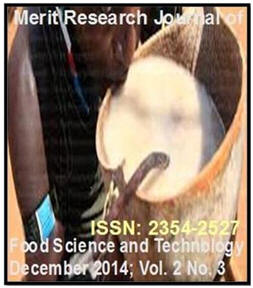
|
|
|
|
|
|
/ / MRJFST Home / / About MRJMFST / / Submit Manuscripts / / Call For Articles / / Editorial Board / / Archive / / Author's Guide / /
|
Other viewing option
• Full text •Reprint (PDF) (139 KB)
Falmata FS
|
Original Research Article Rheological and Microbiological Assessment of Complementary meal produced from Sprouted and Fermented Sorghum (S. bicolor) blended with Cowpea (Vignia unguiculata) and Groundnut (Arachis hypogea) |
|||
|
Falmata F. S.1, Modu S., Sanda S. K.2, Babagana M.1 and Goni Chamba1 |
||||
|
1Department of
Biochemistry, Faculty of Science, University of Maiduguri
Nigeria Accepted December 12, 2014 |
||||
|
Abstract |
||||
|
A variety of
cereals (sorghum) was used singly and in combination with
legumes to produce a number of fermented and sprouted
complementary foods. The study investigated the effect of
sprouting and fermentation singly and in combination on some
functional properties and microbiological quality of the food
formulations produced from sorghum (S. bicolor), cowpea (Vigna
unguiculata) and groundnut (Arachis hypogea) in a
ratio of (70:20:10) respectively. Viscosity, functional
properties and microbiological quality of the food formulations
were evaluated using standard laboratory methods. Sprouting,
fermentation singly and in combination significantly (P<0.05)
decreased gruel viscosities ranging from 197825.1cps –
225.019.4cps for red sorghum and 1952022.9cps – 230018.6cps
for white sorghum variety respectively. The results of the bulk
density ranged from 0.700.01g/ml – 0.600.02g/ml for red
sorghum and 0.710.02g/ml – 0.600.02g/m) for white sorghum,
while an increase in water absorption capacity in sprouted and
fermented sorghum samples for (FCR 6.470.00g/ml, FCW 5.430.01)
and SCR 6.030.00g/ml, SCW 4.410.02g/ml) compared to raw and
the composite blends. Total bacterial counts reduced
significantly with sprouting and fermentation. The dominant
micro organisms isolated in this study were all fermenters non
pathogenic micro-organisms which are safe for consumption
staphylococcus species dominant only in the non-fermented
products. |
Merit Research Journals© 2016 || Advertisement | Privacy policy.
